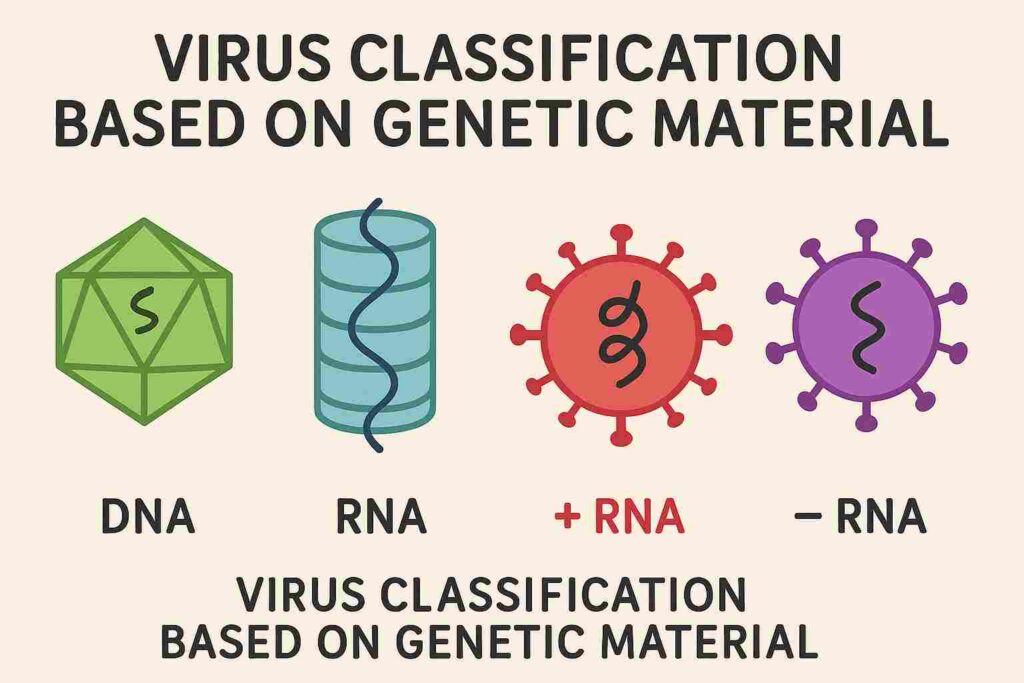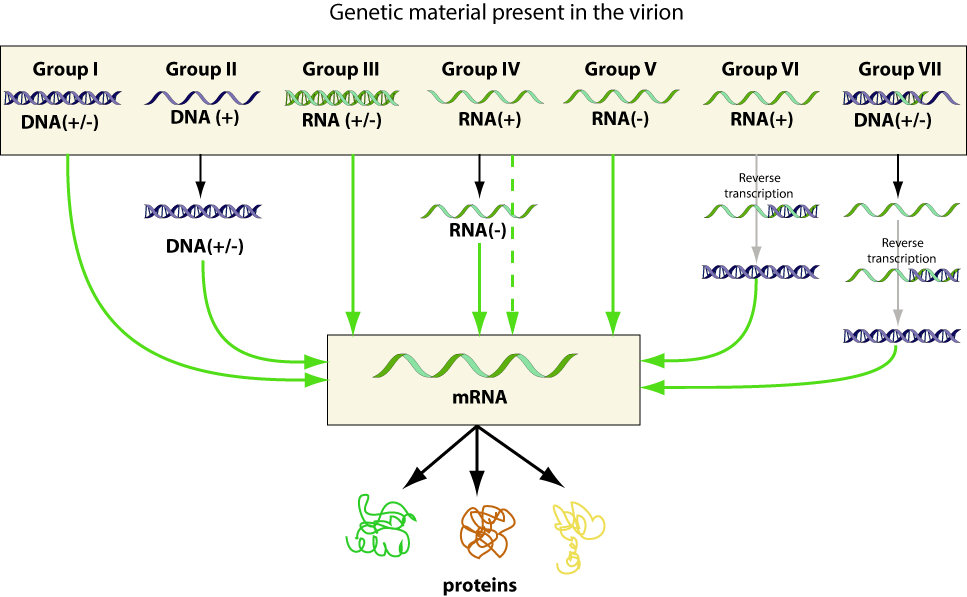Viruses are unique infectious agents that occupy a distinct position in biological classification. Unlike cellular organisms, viruses lack the cellular machinery necessary for metabolism, energy production, and independent replication. They exist in a gray area between living and non-living entities, as they can only reproduce within the living cells of a host organism. Due to their distinctive characteristics and remarkable diversity, classifying viruses poses unique challenges. Multiple classification systems have been developed by virologists over time to categorize viruses based on various criteria such as genetic material, structure, morphology, and mode of replication.
Virus classification is a systematic process by which viruses are grouped and organized based on their genetic, structural, and biological properties.
Summary of Virus classification
- Viruses are classified based on their genetic material (DNA or RNA), structure (capsid symmetry, presence of an envelope), and host range (animals, plants, bacteria, etc.).
- The ICTV system organizes viruses into taxonomic categories like order, family, genus, and species, using criteria such as genome type, replication method, and morphology.
- The Baltimore classification groups viruses into seven categories based on how they produce messenger RNA (mRNA) from their genetic material during infection.
Table of Contents
Definition of Virus
A virus is a submicroscopic, obligate intracellular parasite composed of genetic material, either DNA or RNA, surrounded by a protective protein coat called a capsid. Some viruses possess an additional lipid envelope derived from the host cell membrane. Viruses are incapable of performing metabolic activities on their own and depend entirely on host cellular mechanisms for replication and propagation. They infect a wide range of organisms, including animals, plants, fungi, protists, bacteria, and archaea.
Necessity for Virus Classification
The immense diversity among viruses necessitates a systematic approach to identify, study, and understand their properties, modes of transmission, replication strategies, and associated diseases. Proper classification enables researchers to predict viral behavior, develop diagnostic tools, formulate vaccines, and design antiviral treatments. Moreover, a standardized taxonomy facilitates international collaboration and communication within the scientific community, allowing for effective monitoring and control of viral outbreaks.
Early Classification Systems
Initially, viruses were classified solely based on the type of organism they infected. This crude method divided viruses into categories such as animal viruses, plant viruses, and bacterial viruses (bacteriophages). However, this simplistic system failed to capture the intricate biological differences between viruses infecting similar hosts. Consequently, more refined classification criteria were developed as virology advanced.
Modern Systems of Virus Classification
Classification Based on Genetic Material

One of the most fundamental criteria for virus classification is the nature of their genetic material. Viruses contain either deoxyribonucleic acid (DNA) or ribonucleic acid (RNA) as their genetic core, but never both. DNA viruses can be further subdivided into single-stranded (ssDNA) or double-stranded (dsDNA) forms, while RNA viruses exist as single-stranded (ssRNA) or double-stranded (dsRNA) types. Additionally, single-stranded RNA viruses are categorized based on their polarity into positive-sense (+) RNA and negative-sense (–) RNA viruses. This distinction significantly influences the viral replication strategy and protein synthesis.
Classification Based on Presence of Envelope

Another important classification factor is the presence or absence of a lipid envelope surrounding the capsid. Enveloped viruses possess a membrane derived from the host cell’s lipid bilayer, embedded with viral glycoproteins that aid in host cell attachment and entry. In contrast, non-enveloped (or naked) viruses lack this outer covering and rely solely on their capsid for protection and host cell recognition. This structural difference impacts viral stability, susceptibility to environmental factors, and modes of transmission.
Classification Based on Symmetry of Capsid
The architecture of the viral capsid, which encloses and protects the genetic material, also serves as a basis for classification. The capsid can exhibit various types of symmetry, including icosahedral, helical, or complex forms. Icosahedral viruses possess a symmetrical, spherical capsid composed of 20 triangular faces. Helical viruses have a rod-shaped appearance with protein subunits arranged in a spiral around the nucleic acid. Complex viruses, such as bacteriophages, display intricate structures that do not conform to either icosahedral or helical symmetry and often feature additional components like tail fibers.
Classification Based on Host Range
Viruses display remarkable host specificity, infecting only certain organisms or cell types. Based on their host range, viruses can be classified into animal viruses, plant viruses, bacterial viruses (bacteriophages), fungal viruses (mycoviruses), and archaeal viruses. Even within a host category, some viruses exhibit tissue tropism, infecting specific cells or organs. This host range plays a vital role in understanding disease patterns, transmission modes, and control measures.
Classification Based on Mode of Transmission
The method by which viruses spread from one host to another also contributes to their classification. Viruses can be transmitted through various routes, including respiratory droplets, blood contact, insect vectors, fecal-oral pathways, or direct physical contact. Vector-borne viruses, for example, depend on intermediate carriers like mosquitoes or ticks for transmission. Classifying viruses by transmission mode aids in epidemiological studies and the development of preventive strategies.
The International Committee on Taxonomy of Viruses (ICTV) System
Origin and Purpose
To standardize viral taxonomy, the International Committee on Taxonomy of Viruses (ICTV) was established in 1966. This international body is responsible for devising universal guidelines for the classification and nomenclature of viruses. The ICTV classification system is hierarchical and assigns viruses to progressively broader or narrower taxonomic categories.
Taxonomic Categories in ICTV
In the ICTV system, viruses are classified into several taxonomic ranks, including order, family, subfamily, genus, and species. Orders represent the highest taxonomic category, encompassing families with shared characteristics. Each family, typically ending with the suffix “-viridae,” includes related genera. Genera, ending with “-virus,” contain species with similar properties, and species designates a unique viral type associated with particular biological traits, pathogenicity, and genetic features.
Criteria Used by ICTV
The ICTV employs multiple criteria for classification, including the type of nucleic acid, strandness, replication method, virion morphology, capsid symmetry, presence of an envelope, antigenic properties, host range, and sequence homology. This comprehensive approach ensures accurate grouping and facilitates comparative virological studies.
The Baltimore Classification
Introduction and Rationale
Another widely accepted classification system was proposed by David Baltimore, a Nobel laureate, based on the mechanism of viral genome replication and messenger RNA (mRNA) synthesis. This system addresses the central role of mRNA in viral protein production and categorizes viruses based on how their genetic material is transcribed into mRNA.
The Seven Baltimore Groups

In the Baltimore classification, viruses are divided into seven groups. These include double-stranded DNA (dsDNA) viruses, single-stranded DNA (ssDNA) viruses, double-stranded RNA (dsRNA) viruses, positive-sense single-stranded RNA (+ssRNA) viruses, negative-sense single-stranded RNA (–ssRNA) viruses, RNA reverse-transcribing viruses, and DNA reverse-transcribing viruses. Each group follows a unique pathway to produce functional mRNA and replicate its genome within the host cell.
Significance of Baltimore Classification
The Baltimore system is especially valuable for understanding viral replication strategies and antiviral drug development. By focusing on the steps involved in mRNA formation, this classification reveals potential therapeutic targets and assists in predicting viral behavior under various conditions.
Recent Advances in Virus Classification
Role of Molecular Techniques
Recent advances in molecular biology and genomics have revolutionized virus classification. Techniques such as polymerase chain reaction (PCR), next-generation sequencing (NGS), and phylogenetic analysis provide detailed insights into viral genome sequences, allowing for precise identification and evolutionary comparisons. These molecular methods have uncovered numerous novel viruses and redefined relationships between existing viral taxa.
Metagenomic Studies
Metagenomics, the study of genetic material recovered directly from environmental samples, has expanded knowledge of viral diversity by detecting previously unknown viruses in water, soil, and host-associated microbiomes. These discoveries highlight the vast, unexplored virosphere and necessitate continuous revisions of classification systems.
Clinical and Practical Importance of Virus Classification
Beyond theoretical categorization, virus classification holds profound significance in clinical medicine, public health, biotechnology, and research. It not only enhances our understanding of viral diseases but also aids in developing strategies for diagnosis, treatment, vaccine production, and outbreak management. The following sections discuss the clinical and practical importance of virus classification in detail.
Facilitates Accurate Diagnosis
Accurate identification of viruses is critical for determining the cause of infectious diseases and providing appropriate medical care. Classification organizes viruses based on properties like genome type (DNA or RNA), envelope presence, and host specificity. This categorization enables clinicians and laboratory professionals to select targeted diagnostic techniques, such as PCR assays for specific nucleic acid types or immunoassays for detecting viral antigens.
Guides Appropriate Treatment Strategies
Many antiviral drugs and therapeutic approaches are virus-specific, targeting particular structural or genetic features. Virus classification helps in distinguishing between different types of viruses and choosing suitable treatments. For example, anti-herpes drugs are designed for DNA viruses of the Herpesviridae family, while antiretroviral therapies are tailored for RNA viruses like HIV. Classification thus ensures precision medicine in virology.
Essential for Vaccine Development
Understanding the classification of viruses is indispensable in vaccine research. Viruses within the same family or genus often share antigenic similarities, making it possible to develop vaccines that protect against multiple related strains. Classification also helps predict viral behavior, such as mutation rates and immune evasion mechanisms, which are crucial considerations in vaccine formulation and updates, like those for influenza and COVID-19.
Supports Epidemiological Surveillance
Effective public health surveillance requires systematic tracking of viral infections and their spread patterns. Virus classification assists epidemiologists in identifying outbreak sources, monitoring emerging variants, and predicting potential public health threats. By grouping viruses into families and genera, classification streamlines data collection, reporting, and disease control measures at local, national, and global levels.
Aids in Predicting Virus Behavior
Classifying viruses provides insights into their preferred hosts, modes of transmission, and replication strategies. This predictive capacity is vital for anticipating disease outbreaks and implementing timely preventive measures. For instance, knowing that certain arboviruses are vector-borne informs vector control programs, while recognizing airborne virus families prompts the enforcement of respiratory hygiene measures.
Helps in Designing Laboratory Diagnostic Methods
Different virus classes necessitate specific diagnostic techniques. Virus classification informs laboratory staff about the most suitable detection methods, whether it involves nucleic acid amplification for RNA viruses, electron microscopy for structural analysis, or antigen detection for enveloped viruses. This ensures the efficient and accurate identification of viral pathogens in clinical settings.
Contributes to the Understanding of Virus Evolution
Classification reveals evolutionary relationships among viruses, shedding light on their origins, genetic variations, and adaptation mechanisms. Studying viruses within the same family allows virologists to trace how viruses evolve, develop drug resistance, or cross species barriers. This evolutionary insight is fundamental for long-term disease control and pandemic preparedness.
Informs Infection Control Practices
Effective infection control relies on understanding viral transmission routes, environmental stability, and susceptibility to disinfectants — all of which are influenced by viral classification. For example, enveloped viruses are generally more sensitive to detergents than non-enveloped viruses. Knowing a virus’s class helps determine appropriate decontamination protocols, isolation measures, and personal protective equipment (PPE) guidelines in healthcare settings.
Facilitates Research Collaboration and Data Sharing
A universal virus classification system standardizes terminology and reporting, enabling seamless communication and data exchange among researchers, clinicians, and public health authorities worldwide. This uniformity promotes collaborative research, accelerates scientific discoveries, and improves coordinated responses to viral epidemics and pandemics.
Critical for Biotechnological and Therapeutic Applications
Classified viral systems are invaluable in biotechnology, where specific virus types are used as vectors in gene therapy, vaccine delivery, and cancer treatment. For instance, adenoviruses and lentiviruses serve as popular gene delivery vectors due to their well-characterized properties. Classification ensures that suitable and safe viral systems are selected for medical and industrial applications.
Conclusion
The classification of viruses is a complex yet essential aspect of virology, enabling systematic study and effective disease management. From early host-based groupings to sophisticated molecular and genomic analyses, virus classification has evolved significantly. Modern systems like the ICTV taxonomy and the Baltimore classification provide complementary frameworks that consider genetic material, replication mechanisms, structural features, and host specificity. With rapid advances in technology and molecular biology, virus classification continues to progress, revealing the immense diversity and adaptability of these fascinating biological entities.
Frequently Asked Questions (FAQ)
What are the 4 classifications of viruses?
Viruses can be classified based on genetic material (DNA or RNA), capsid symmetry (icosahedral, helical, or complex), presence or absence of an envelope, and host range (animals, plants, bacteria, etc.).
What is 7 virus classification?
The 7 virus classification refers to the Baltimore system, which groups viruses into seven classes based on their genome type and method of mRNA synthesis.
Which are the types of viruses?
Types of viruses include DNA viruses, RNA viruses, enveloped viruses, non-enveloped viruses, animal viruses, plant viruses, bacteriophages, and fungal viruses.




